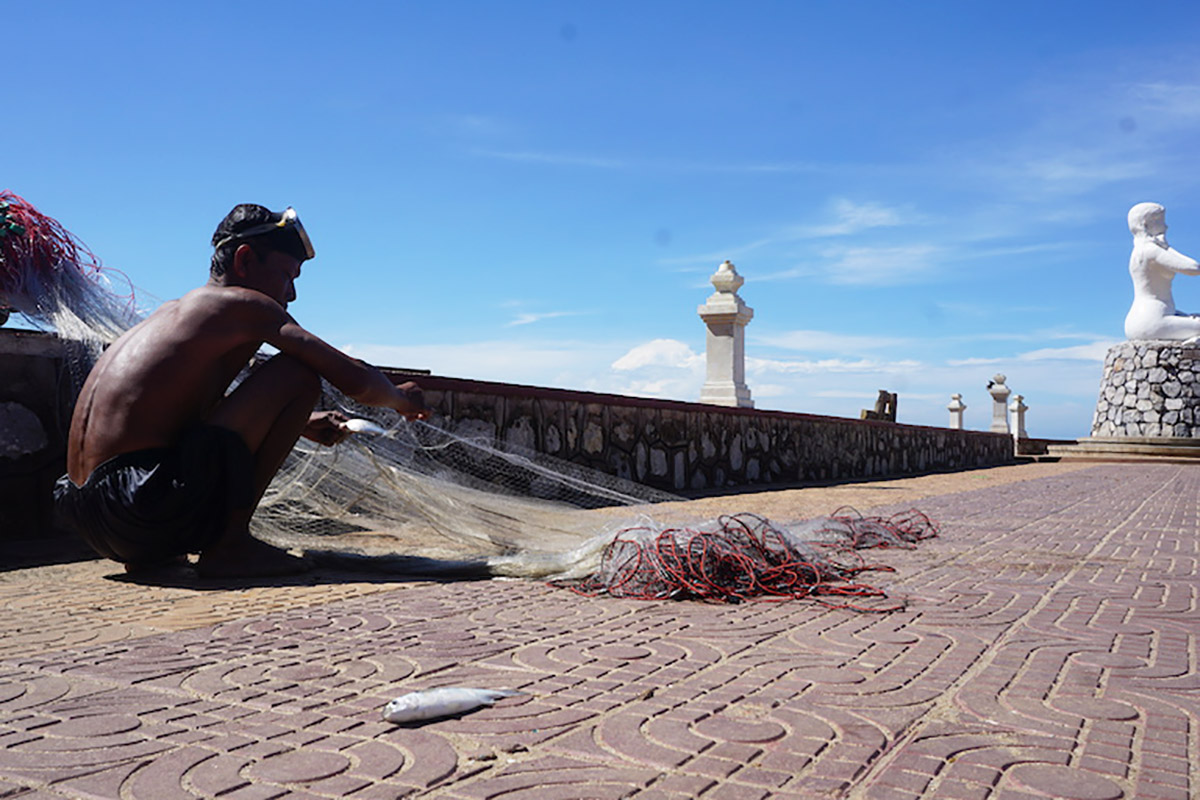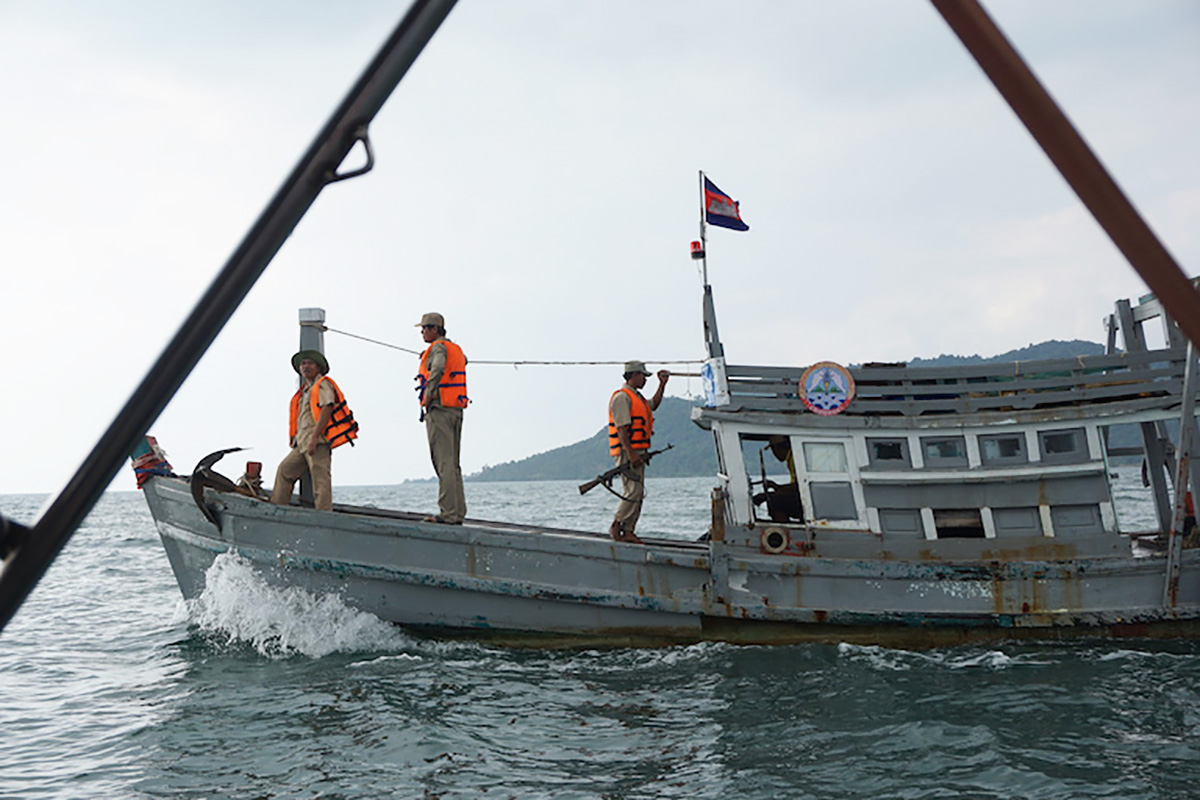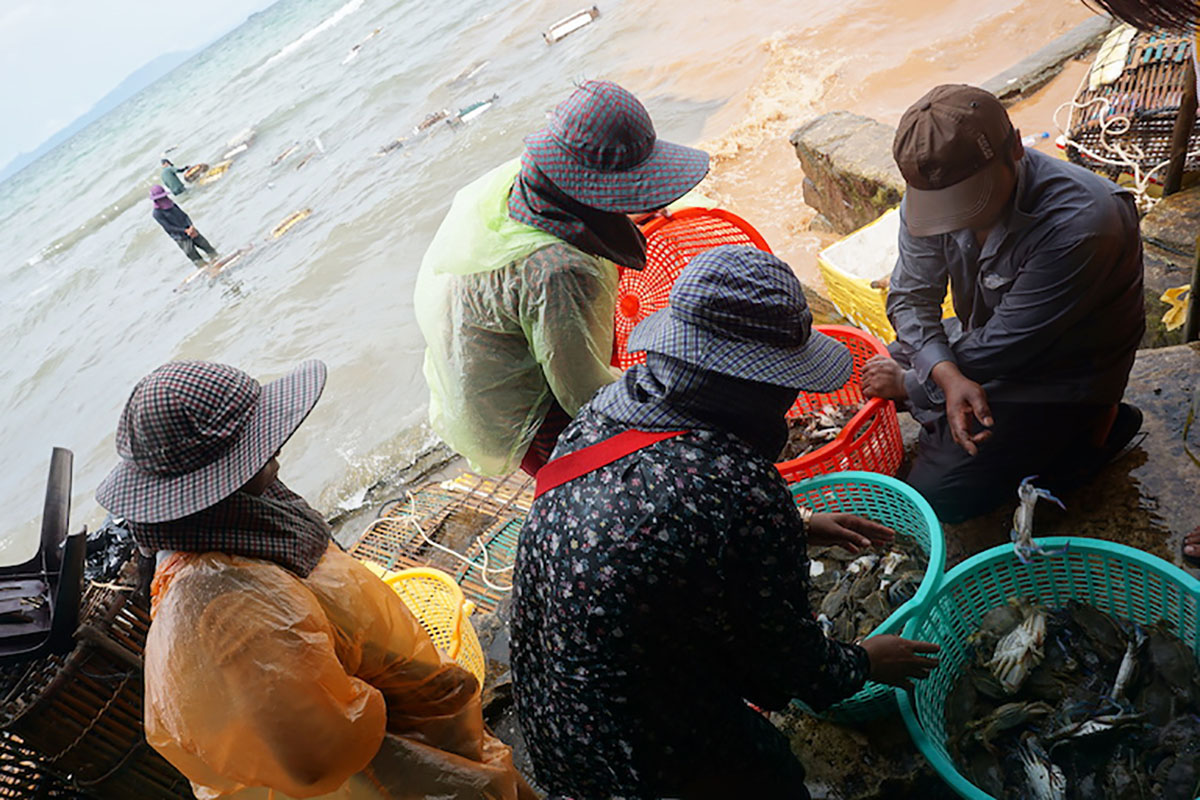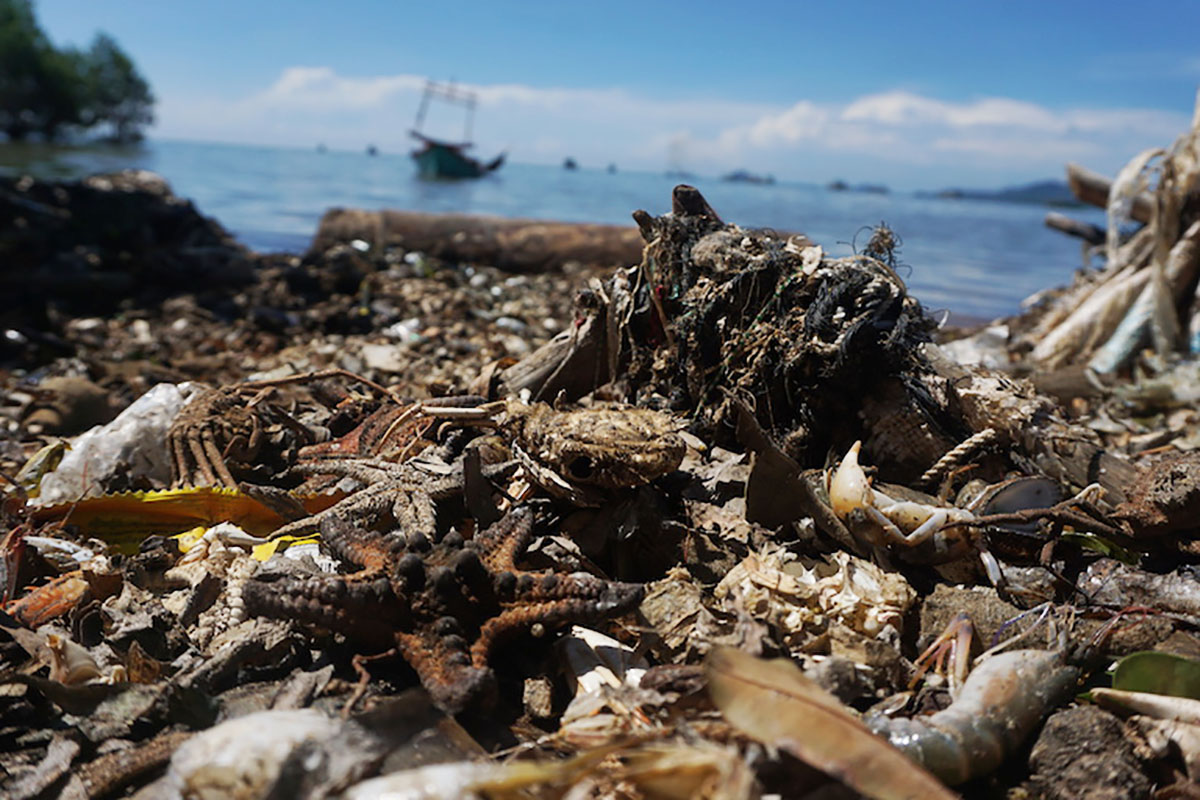It’s not long before midnight and an outlaw trawler has been spotted. The captain – a weather-gnarled old fisherman wearing just boxer shorts – winces as flashlights illuminate his face. He takes a drag of a cigarette and grins as his crew hauls in their catch. “Here he is with all the seagrass in his net,” says Paul Ferber, the founder and head of Marine Conservation Cambodia (MCC), as his boat pulls alongside the trawler to take video evidence during a patrol for illegal fishing. “Same guy. He just doesn’t care.”
For nine years, the NGO MCC has been documenting the decline of marine ecosystems off the southern coast of Cambodia, where fish stocks have plummeted as once-thriving habitats are reduced to a sludgy underwater wasteland. The main perpetrators of the destruction are fleets of trawlers that drag weighted, electrified nets through the shallow waters here almost every night. Their main target is shrimp but their methods are indiscriminate. Like a bulldozer through forest, they cut swathes of life out of the sea and scars into the ocean floor. Sunken a few inches into the seabed, the nets churn up and electrocute everything in their path, including the seagrass meadows that once sprawled the bay.
After more than a decade of intensive trawling, the ecosystem is at the brink of collapse by MCC’s assessment. “There’s not much left out there,” said Ferber, 40, a British diver who has been living on Koh Seh, the most remote island in the Kep Archipelago, for almost four years. “In some places, there are no signs of life at all. It’s just dead.”

In this picture taken on December 15, 2017, shows a man pulls a second fish from his hand net on the edge of Kep Bay. All along the coast, subsistence fisherman report increasing difficulty in making ends meet. (Mongabay/Matt Blomberg)
In Kep and around the world, seagrasses, a critical but oft-forgotten element of marine shallow-water ecosystems, are in decline. Their extensive root systems form webs that bind and stabilize the substrate, in the same way that land grasses work against erosion. From this foundation, habitats flourish. In open waters, seagrass meadows provide shelter for fish and invertebrates to mate and to store their eggs. They are a nursery for juvenile shrimp, fish and seahorses taking cover from ocean currents and predators. Turtles and dugongs feed directly on seagrasses, and dolphins feed on organisms that live within them. When seagrasses decompose, worms, sea cucumbers and phytoplankton feast on the nutrients.
And, perhaps most importantly, seagrass meadows capture and store carbon dioxide in the same way that forests do, often at a superior rate, combating rising water temperatures, acidification and climate change. “It’s simple,” said Ferber, “if the seagrass is gone, the entire habitat is gone.”
From carbon sink to carbon source
Globally, seagrasses are disappearing at a rate of 1.5 percent per year, releasing in excess of 150 million tons of carbon dioxide into the atmosphere, equivalent to the emissions of 31.5 million cars, according to the International Union for Conservation of Nature. In the Kep Archipelago, which lies along the border between the Gulf of Thailand and the South China Sea, or Cambodia and Vietnam, seagrass meadows are being destroyed, and carbon is being released, much faster.
“Our estimated rate of loss for the whole South China Sea is 30 percent per decade,” said Chris Paterson, a fisheries expert at the Southeast Asian Fisheries Development Center, an intergovernmental management body headquartered in Thailand. “The transboundary waters in and around Kep is where the largest percentage of the 78,000 hectares of seagrass in the South China Sea are located. The rates of loss are the highest anywhere globally.”
Researchers estimate that an average hectare of seagrass can store at least 250 metric tons of carbon, enough to offset the emissions of one car for more than 50 years. The Nature Conservancy calculates that, since 1990, seagrass beds have neutralized some 2,373 billion tons of carbon. However, over the same period, trawlers, development, climate change, and other destructive forces have collectively uprooted enough seagrass to release 4,132 billion tons of stored carbon back into the atmosphere. Like the world’s tropical forests, as a paper in the journal Science recently reported, the world’s seagrass meadows have collectively become a source of carbon rather than a sequesterer of it.
Dwindling catches
About 15 kilometers from the mainland of Kep province, MCC cultivates a refuge for sea life around its tiny island base of Koh Seh as the greater sea is stripped bare by commercial poachers from Cambodia and Vietnam. Under the protection of an MCC patrol team that remains on standby 24 hours a day, the seagrass meadows that fringe Koh Seh are once again expanding and, as marine populations return to the waters, subsistence fishers are hauling in their best catches in years.
And so, MCC has developed a plan to expand its conservation work to the entire Kep Archipelago. Backed by the government’s Fisheries Administration, the group is working to establish a Marine Fisheries Management Area (MFMA) encompassing nine islands, 11,354-hectares of ocean once-teeming with life, and thousands of families whose livelihoods are being derailed by the devastation of the marine habitats around them.
“Those small-scale fishermen that work to feed their families, they are the big victims here,” Ferber said. “The larger scale commercial boats ruin it for everyone.”
The mainland village of Phum Thmei is in a state of transformation. Roadside grocery stores are popping up where tangled piles of fishing gear once lay, and traditional family structures are breaking down as members leave home to toil in unfamiliar industries.
For as long as anyone here can remember, this coastal community of some 600 households has lived comfortably from the sea. “In years past, you didn’t have to go looking for fish,” said Prak San, 65, the chief of the Phum Thmei fishing community. “You’d just enter the water and they would come to you.”
But as marine populations dwindled, fishermen took to using nets with smaller and smaller mesh sizes, meaning that species are being harvested long before maturity, making it increasingly difficult for them to recover. San gave an example: “Two crabs used to equal one kilogram. Now you need 10 crabs to make a kilo.”
The village leader estimates that less than 30 percent of his people now make their living from the sea, with the rest turning to unskilled endeavors such as trading small goods or laboring on construction sites. “The trawlers destroy everything, including the environment and our fishing gear,” he said. “There is almost nothing left for us.”
In a country where bribery is a major currency, subsistence fishers have little recourse against poachers, creating a tinderbox that sometimes explodes in violence. A Cambodian fisherman, for example, was killed in a 2015 clash with Vietnamese intruders. No one has been held to account.

In this picture taken on December 15, 2017, shows the Cambodian Fisheries Administration out on patrol in Kep Bay, responding to a call from MCC. (Mongabay/Matt Blomberg)
When asked how the proposed MFMA would work for his community, San turned nostalgic, harking back to his heyday on the water, when dugongs and turtles prospered and dolphins raced alongside his wooden longtail boat. The MFMA “is the best thing that could happen,” he said. “The fishermen will once again see the benefits of allowing marine life to mature in a refuge area before being harvested.”
Indeed, there is very little incentive for any of the responsible parties to cease destroying Kep’s marine ecosystems. At least, none that supersede the immediate needs of a family literally living from hand to mouth.
At Phsar Kdam, a seafood market and string of restaurants that overlooks Kep Bay from the Cambodian mainland and takes top billing among local tourist attractions, crab-sellers scurry between customers on land and bamboo cages bobbing in the shallows. Crawling with live crabs, the cages are dragged ashore as buyers and sellers negotiate prices. Amid a cacophony of offers and counteroffers, one word – toich, or small – is omnipresent. Legendary across Cambodia for their size and succulence, the blue swimmer crabs (Portunus armatus) are now rarely bigger than the hands of their sellers.
“Kep is famous for this species,” said Khat Chai, a 34-year-old hawking live crabs to the hordes of domestic tourists visiting the bay during a religious holiday in September. “It’s the reason people come here. No matter how much smaller they get, we will keep harvesting.”
Chai said he was well aware that current harvesting patterns were not sustainable and would eventually leave a whole network of people looking for alternative revenue streams. But he reasoned like a man living on the edge of poverty – the reality for most residents of Cambodia’s coastal fishing villages. “Sure, it will have an effect on our community, but we are living for today only,” he said. “If we don’t do this, how should we feed our families?”
A refuge for sea life
Trawling in Kep Bay is categorically illegal and punishable by jail. However, both Cambodian and Vietnamese vessels ply the waters here mostly uninterrupted. Marine police, charged with protecting borders, mostly ignore or deny reports of commercial Vietnamese fishing boats entering Cambodian waters. Officers from the government’s Fisheries Administration, charged with enforcing local fisheries laws, claim that they are doing their best with scant resources. Illegal fishing activities are ubiquitous but arrests are rare. Charges and convictions are almost unheard of.
Over the years, MCC has enjoyed sporadic cooperation with local-level officials in its quest to have the trawlers run out of Kep Bay. The group’s work educating communities in sustainable fishing methods, lobbying officials over environmental and tourism issues, and confiscating illegal gear from outlaw poachers in partnership with government Fisheries Administration have all helped make inroads. But gains are often swiftly reversed, usually because the incentive to fish is greater than the incentive to not fish.

In this picture taken on December 15, 2017, shows crab sellers sort their wares at Phsar Kdam in Kep, Cambodia. (Mongabay/Matt Blomberg)
And so, the planned MFMA lends a more direct thrust to MCC’s conservation efforts in Kep. The group will begin by dropping 52 anti-trawling devices at strategic locations, marking out the border of the MFMA and also the various zones within it. The anti-trawling devices are rigid structures assembled underwater by layering concrete pillars in the shape of a hexagon and fixing them together with steel rods. Weighing more than three tons each, they will catch nets and stop trawlers in their tracks.
“They are our eyes and ears,” Ouk Vibol, director of the Fisheries Administration’s Department of Fisheries Conservation, said of MCC. “We do not have the manpower or the budget to control all illegal fishing activities but this MFMA gives us a pilot area where we can begin to enforce the fisheries law,” he said. By February, Vibol said, the plan should have its final approvals and fisheries officers and marine police will be hard at work enforcing it.
“Just keeping the trawlers out of here for a while will have a massive effect,” Ferber said, explaining how the constant churning of the seabed changes the composition of the substrate. “You are left with this sloppy, muddy sediment, devoid of nutrients and full of bacteria, that gets dragged around and settles in other places, smothering whatever life exists and making it difficult for seagrass to retake because there is no decent substrate to take to,” he said.
The anti-trawling structures will also act as artificial reefs, attracting bivalves, sponges, barnacles and algae, which in turn will attract organisms such as oysters and mussels, all of them naturally filtering the water and offsetting the threat of toxic algal blooms. “The vision is to establish what you could call natural aquaculture over 11,000 hectares, a giant farm that doesn’t need caring for aside from stopping illegal and destructive activities. Then this place would be productive enough to look after all the coastal communities,” Ferber said. Eventually, the artificial reefs could be expanded and harvested for oysters, potentially presenting illegal and destructive fishers with a more sustainable way to make a living.
For now, though, the trawlers remain at work, dredging up carbon that is heating and acidifying the ocean, their piles of uprooted seagrass decomposing and overloading the sea with nutrients. Consequently, Kep’s waters are facing more frequent toxic algal blooms. “It is a cry for help from the ocean,” Ferber said. “It is an ecosystem in collapse. When toxic algae blooms happen, your ecosystem has imploded, and it is telling you that it cannot cope anymore.”
The blueprint for restoration exists, however. It lies at the bay’s furthest reaches, off the eastern shores of Koh Seh, where the difference between abuse and sustainable use of fisheries can be seen thriving in the waters MCC currently protects. Extrapolating from its current site, MCC’s proposal for the Kep Archipelago bans all trawling, delimits zones for tourism and development activities, and returns more than 90 percent of its total area to the subsistence fishermen who have seen their hunting grounds destroyed by outlaw poachers.
The plan also imposes two no-take zones, around Koh Seh and the neighboring island of Koh Angkrong, where all fishing activities will be strictly forbidden. That 112 hectares – about 1 percent of the MFMA’s total area – will become the staunchly-protected heart of a sanctuary designed to feed life back into the entire bay.
“Those areas are almost like your castle, your final stand,” Ferber said. “You’ve just got those two bits you can work from. But as long as you have something to work from, you can always recover other areas.”
This article first appeared on Mongabay.
Mongabay is an environmental science and conservation news and information site.
Recommended stories:
-
Singapore's home sales gain with annual tally highest since '13
-
New report exposes a plethora of pangolin trafficking routes in Southeast Asia
-
Go-Jek acquires three companies to dominate payment in Indonesia
